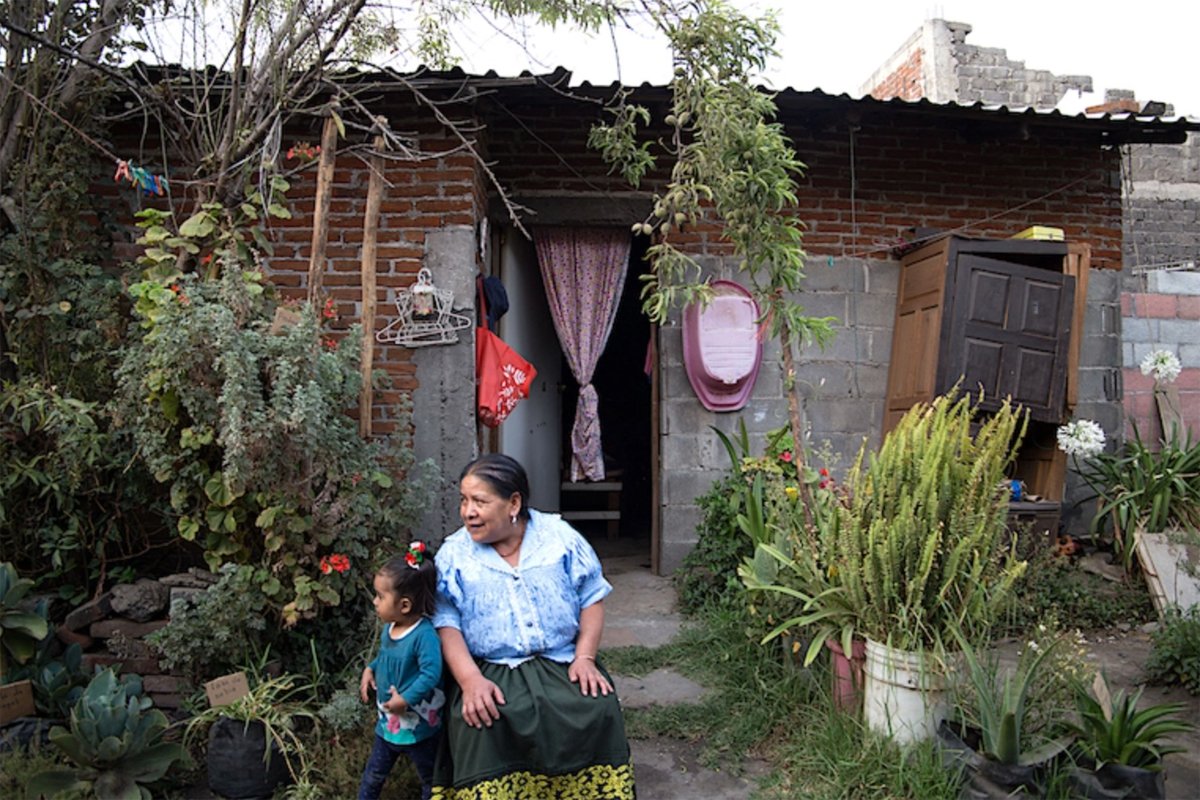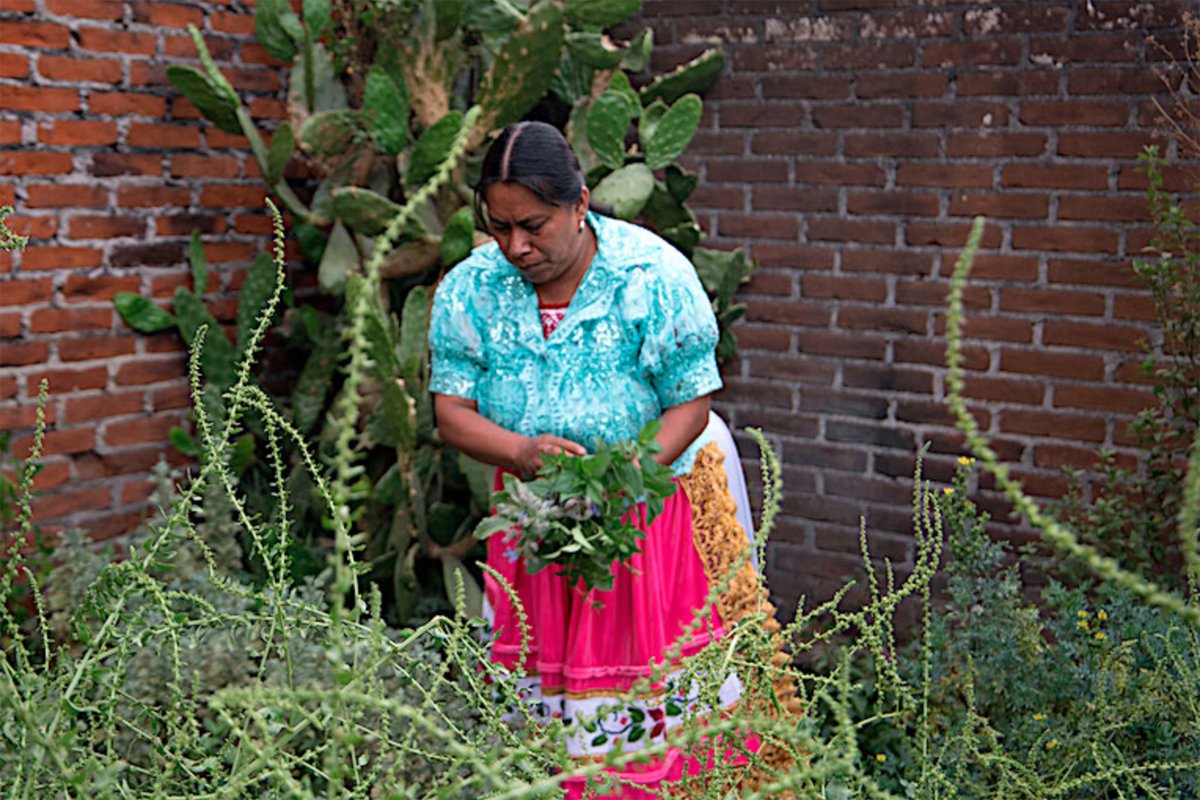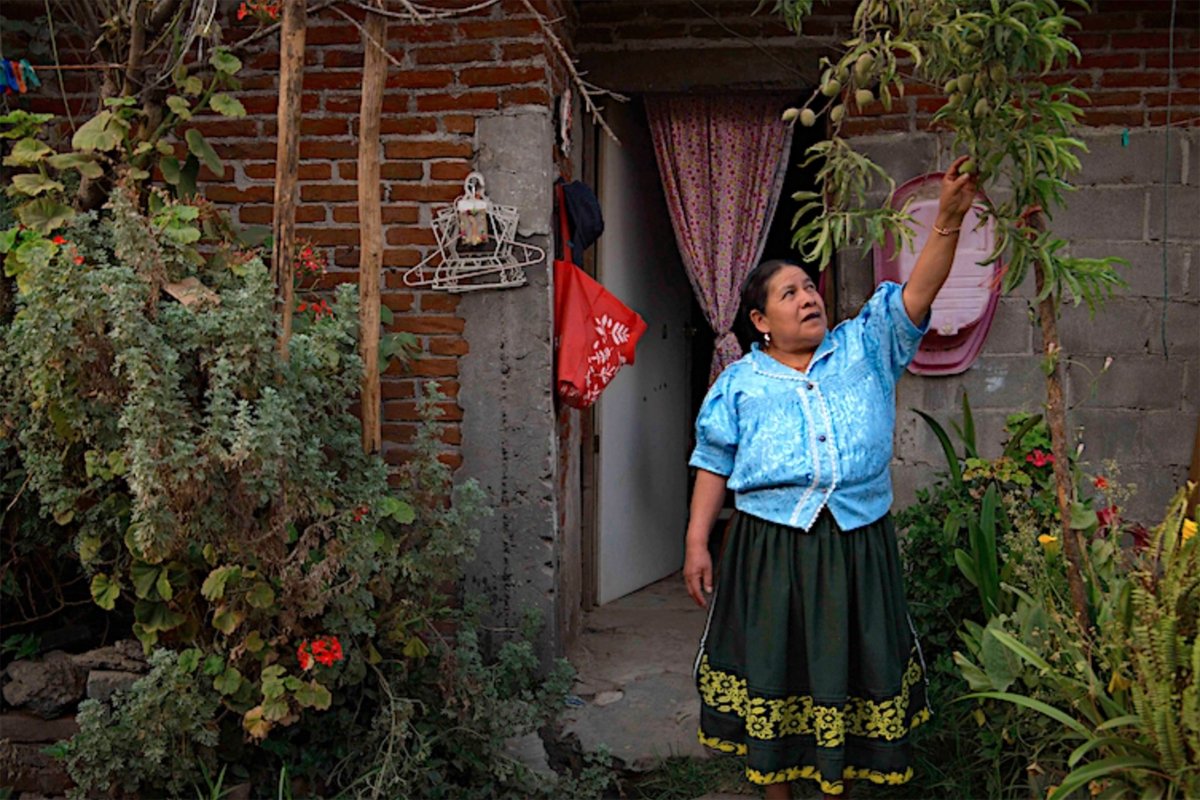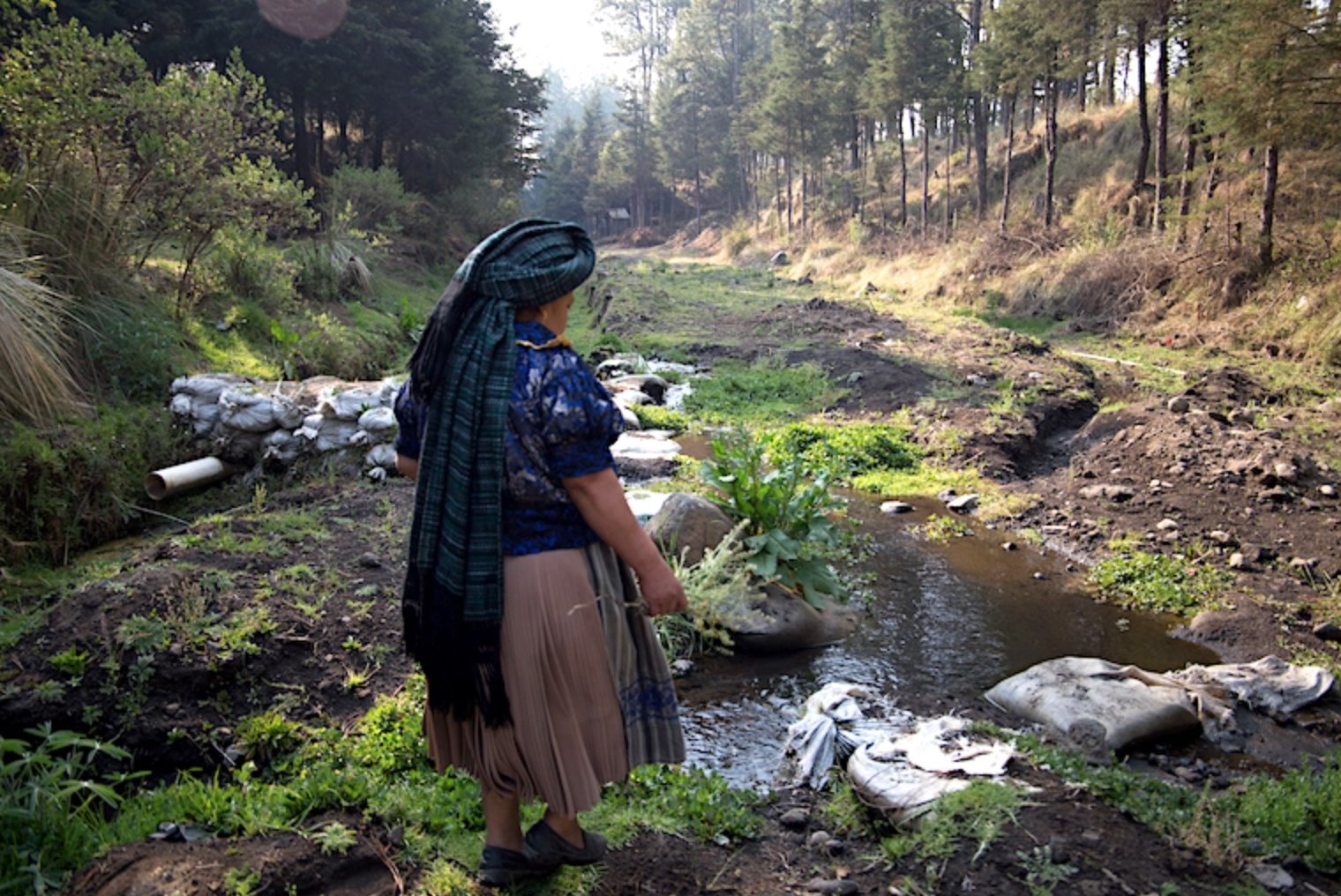Avocado farms–mostly supplying the U.S. market–dominate water resources in the Mexican town of Angahuan, forcing Indigenous P’urhépecha healers to buy clean water to keep their medicinal plants alive.

Avocado farms–mostly supplying the U.S. market–dominate water resources in the Mexican town of Angahuan, forcing Indigenous P’urhépecha healers to buy clean water to keep their medicinal plants alive.
June 10, 2022

“Naná” Gracia is an Indigenous P’urhépecha healer and midwife, seen here in her ekuarho agroforestry plot with granddaughter Alma. (Photo credit: Monica Pelliccia)
“Cuchita is the fourth-generation herb collector of our family,” says Juana Bravo, 45, pointing to a photo of her niece. “Look here: She was picking medicinal plants in the mountains when she was only one and a half years old.” Maria de Jesus, called Cuchita, now 9, still shares that same passion with her aunt. Today, after school, she joins Juana to prepare an antiseptic salve with medicinal herbs collected from the patio garden right outside their door.
Angahuan, a town of 6,000 inhabitants in the Mexican state of Michoacán, has several generations of Indigenous P’urhépecha women practicing traditional medicine. Juana and Cuchita are part of this group of a dozen curanderas, healers known for their use of herbal medicine and commonly called tsinajperi (“the ones that make life grow”) in the P’urhépecha language. They’re also highly sought out for their skills in midwifery and the traditional Mesoamerican massage technique called sobada.
Medicinal plants like gobernadora (also called creosote, Larrea tridentata), ruda (Ruta graveolens), prodigiosa (Brickellia cavanillesii), and nurite (Satureja macrostema) are central to their cosmology and are cropped on a small scale in their diverse patio gardens called ekuarho. It’s a traditional agroforestry system that combines timber trees, fruit trees, medicinal plants, vegetables, and flowers in a group that grows well together, with each plant benefiting from the shade and moisture they’re afforded in the dry climate. It’s like a tiny pharmacy always on hand, located just outside the kitchen, with herbs used in remedies for digestive problems, insomnia, or pain.

Juana Bravo, an Indigenous P’urhépecha healer, collects herbs from her ekuarho agroforestry garden to prepare a salve and medicinal tea in Angahuan, Michoachán, Mexico. (Photo credit: Monica Pelliccia)
The P’urhépecha are one of the 68 Indigenous groups of Mexico, and traditional medicine is one of the main pillars of their culture, in which agroforestry plays a big part. But this heritage is now endangered by water shortages caused by climate change-driven drought and by agribusiness: Avocados are a lucrative export—80 percent of Michoacan’s crop is shipped to U.S. grocery stores—and their plantations dominate the landscape for much of the 40 kilometers (25 miles) between Angahuan and the neighboring city of Uruapan.
“P’urhépecha women have a fundamental role in the richness of Indigenous territories’ preservation: They are the custodians of the plant wisdom used for medicine, ritual, and food,” says Rosendo Caro, director of the Forestry Commission of Michoacán State (COFOM). “Their legacy is endangered by avocado development in the region. This business consumes the water previously used for the ekuarho, deteriorates soils with agrochemicals, and has long-term consequences on water resources.”
Where’s the water?
Juana’s patio garden contains several important P’urhépecha medicinal herbs such as governadora, epazote (Dysphania ambrosioides), Vicks plant (Plectranthus hadiensis), poleo (Mentha pulegium) and white horehound (Marrubium vulgare). These are interplanted with edible plants like opuntia cactus and cabbage, which are used to prepare meals like atapakua mole and pozole.

Juana Bravo, an Indigenous P’urhépecha healer, collects herbs from her ekuarho agroforestry garden to prepare a salve and medicinal tea in Angahuan, Michoachán, Mexico. (Photo credit: Monica Pelliccia)
“The ekuarho is a pre-Hispanic agroforestry system typical of the P’urhépecha population,” says biologist Maria del Carmen Godínez. “In the beginning, it was developed in the woods: People were sowing maize with pumpkins, chili, and beans, taking advantage of forest products such as timber, medicinal plants, or mushrooms. Then, after the conquest, they brought it to the population centers. Now, it is easier to find in backyards than in the woods. However, while P’urhépecha communities increased in population, the ekuarho became fewer and smaller due to property fragmentation.”
In Angahuan, the ekuarho is still the center of the curanderas’ daily life. Here they grow medicinal plants, fruits, and vegetables, pines for construction materials, and flowers for everyday enjoyment. The women also enjoy the patio gardens’ shade, sharing family moments, or working on embroidery out of the boiling sun.
But before the rainy season, the soil here is dry like sand. “It is difficult to continue to work as traditional healers with the water scarcity that has increased during the last five years,” Juana says. She wears the traditional P’urhépecha dress with a long, pleated skirt, apron, and an embroidered shirt covered by blue-and-black-striped shawls.
“In the drought season, we do not have many plants, and sometimes they dry up. We have to wait for the first rains to make everything sprout,” she says. A peach tree recently died of thirst on the patio, so her husband Nacho transformed it into a table. But every morning as the first rays of the sun filter into the garden, she waters her plants with a basin.
“I use only a bit because we have to avoid waste,” she explains. “We have running water only every three days for just an hour, normally from 8 to 9 a.m. I use recycled water [and still] we need to buy gallons in shops to prepare salves and essential oils.”

“Naná” Gracia checks the ripeness of a peach in her ekuarho, a traditional agroforestry plot outside her home composed of fruit trees, medicinal herbs, vegetables, herbs and flowers. (Photo credit: by Monica Pelliccia)
A Fourth-Generation Legacy
Learning traditional medicine from her grandmother, Victoria, is one of Juana’s precious childhood memories. “We used to collect black cherries and herbs in the woods. But now, fewer trees surround us due to orchard development and sawmill commerce,” she says. After Juana grew up, she pursued professional training in Uruapan to help her community as a curandera.
“When I was young, all the women were herb collectors,” says Juana’s mother, Maria Teresa, 67. “At that time, we didn’t have a medical center in the village, this was the only option for us.”
Currently, there are fewer curanderas in Angahuan, but they are joined in their efforts by women such as “Naná” Gracia Bravo, 57, a third-generation midwife and mother of five. Her house is a few steps from Juana’s, among street food stands and stores selling diverse products, from ice cream to jewels. From early morning until night, vendors announce quick-stop meals like pozole.
Walking the dusty streets, almost everyone knows Gracia. “Do you want a soft drink?” a couple of men say to her while passing in front of the shops. “It is always like that,” Gracia says with a smile. “I have been doing this job for 40 years. When I walk in the street, sometimes people stop me and offer me a soft drink because I was supporting their mothers during childbirth.”
Currently, she is taking care of five women, giving maternal sobada massages. Today, Maria Guadalupe, 27, six months pregnant, comes to her house. Gracia massages her belly with an essential oil to check if all is going well. She ends with a special caress of greeting: “Although we did not say it, a good thought arrives to the baby,” she says.
Gracia makes medicines with herbs from her agroforestry garden like governadora under the peach tree’s cooling shade, and boils clean water she had to buy in a shop on her parangua, the traditional P’urhépecha kitchen fireplace. She seems to always be busy preparing herbal remedies or essential oils for her patients, and many of these require water.
Thirsty Avocados
In Angahuan, some inhabitants don’t have running water at all, like Apollonia Cortés, 67, mother of 12, living outside of the town center. She’s one of the oldest midwives here, with long gray hair brushed into two red-and-blue braids.
In her ekuarho, tall pines provide shade for fruits such as chayote (Sechium edule) and black cherry (Prunus salicifolia), plus vegetables like cabbage, opuntia cactus, and medicinal plants.
“In the past, we had a lot of plants, but now everything is almost dry, due to lack of water,” explains Leonarda Soto, 29, Apollonia’s daughter-in-law, while her three kids play with a dog and some rabbits on the patio. “We have to buy water when it is not the rainy season. People take water from our freshwater spring: It is a problem.”

“Naná” Gracia collects wild medicinal herbs like horsetail and Virginia pepperweed at the edges of the community spring. (Photo credit: Monica Pelliccia)
Angahuan’s water provision point is a couple of kilometers from town, a short drive on dusty roads as Paricutín, the youngest volcano in Mexico, looms nearby.
“What is happening to the Angahuan spring is a common problem for P’urhépecha living in this area,” says COFOM’s Caro, “as they are located in the upper basin, and rains are not able to create streams, because water infiltrates into the permeable, volcanic soil. There are only a few hydrological deposits available [and they] are very [overutilized].”
The curanderas collect wild medicinal herbs in the spring’s surroundings, and Gracia sometimes goes there in the early morning. Today, two jeeps are pumping water into big tanks. “Have a look: They bring water to their avocado orchards, and for this reason, there is not enough for the community,” Gracia says, after greeting them and continuing her stroll.

Avocado farmers fill large tanks like this daily at the community spring, reducing water availability for the community and its curanderas. (Photo credit: Monica Pelliccia)
While walking, she protects her head from the sun by making a turban from a shawl, and collects herbs such as cola de caballo (Equisetum arvense), lentejilla (Lepidium virginicum), and some flowers to decorate the house.
For the healers, wild herb gathering is getting difficult. Some parts of the wood are fenced with wire, now part of avocado orchards, and medicinal plants such as arnica (Arnica montana), a herb used to make anti-inflammatory salves, can’t be gathered due to the neighbors’ irrigation.
“In Angahuan, the avocado crop has taken [over] in the last decade, with approximately 800-1,000 hectares [of them],” Caro says; that’s about 2,000-2,500 acres. “Usually, it starts with an association between people from the community and external agents that give the money to clear [the land], and for the time until the first harvest, [about] five years. The maintenance expenses are difficult to bear for an Indigenous farmer. At the end, when the orchard is productive, the external agent becomes the owner, with money or by force.”
Collective Effort Toward Rainy Days
Starting from their patio gardens, the P’urhépecha people are planting seeds of resistance. “In our ekuarho, we have a tree nursery. My husband and brother have already planted 500 pine trees on the hills. They want to stop the avocado a bit, to do reforestation, and help to retain water,” explains Gracia.
“The ekuarho system must be preserved: It represents P’urhépecha families [and] their bond with the land,” says Erandi Rivera, a National Autonomous University of Mexico (UNAM) professor and agroforestry expert. “But we can’t protect it without collective political efforts: People are tired of state and criminal violence, and since 2011, most of the P’urhépecha communities are building autonomous governance structures.”
In Angahuan, they have self-government, according to Michoachán state law. Among other initiatives, they patrol 600 hectares (1.500 acres) of woodland managed by the local Communal Surveillance Council. Tree clearing is forbidden, and people are allowed to collect wood only when it falls naturally to the ground. The timber can be used only for community purposes, such as schools or churches, and not sold.
For the curanderas, it is a struggle to preserve their legacy. Juana, Gracia, Cuchita, and their neighbors have created a collective of traditional women healers called Emenda (“Rainy Times”), inspired by the era when water and medicinal plants were more readily available. Last year, the Michoacán state government recognized them with an award for entrepreneurship.
Despite the difficulties, the group continues to dream big. They want to open a natural pharmacy in town to sell teas, salves, shampoos, and remedies made with herbs collected in a dedicated ekuarho, with a room for sobada massage.
“We want to give value to traditional medicine with a project run by women that care for life and nature,” says Juana of the dream to continue the P’urhépecha curanderas’ legacy through to future generations.
This article originally appeared in Mongabay, and is reprinted with permission.

September 4, 2024
By paying top dollar for milk and sourcing within 15 miles of its creamery, Jasper Hill supports an entire community.
September 3, 2024

August 27, 2024

August 26, 2024

Like the story?
Join the conversation.